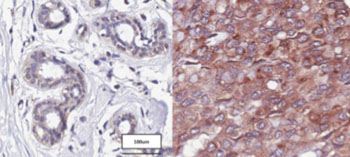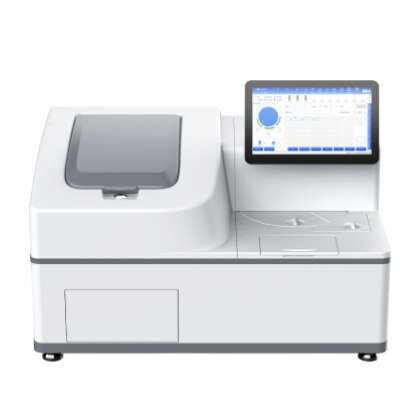DP103 Cited as Breast Cancer Biomarker and Potential Treatment Target
By LabMedica International staff writers
Posted on 03 Sep 2014
Cancer researchers in Singapore have identified the DP103 oncogene in human breast cancers as a biomarker for the molecular processes that drive reappearance and metastasis of tumors following chemotherapy.Posted on 03 Sep 2014
The 824-amino acid DEAD-box protein DP103 belongs to the family of DExD/H-box proteins, named after the signature Asp-Glu-Ala-Asp/His motif within the helicase domain (Gemin3, DDX20). DP103 was originally cloned and characterized as a component of the splicing machinery in concert with SMN, Sm, and other Gemin proteins.

Image: Difference in DP103 (red) levels in a healthy person (left image) and a breast cancer patient (right image) (Photo courtesy of the National University of Singapore).
Investigators at A*STAR’s Institute of Molecular and Cell Biology (Singapore) and at the National University of Singapore's Cancer Science Institute have identified DP103 as a biomarker and metastasis-driving oncogene in human breast cancers. Furthermore, they determined that DP103 elevated matrix metallopeptidase 9 (MMP9) levels, which are associated with metastasis and invasion through activation of NF-kappaB.
The NF-kappaB family of transcription factors comprises five structurally related proteins that form homo- and heterodimers through their highly conserved DNA binding/dimerization Rel homology domain. Binding of NF-kappaB to IkappaB proteins maintains NF-kappaB in an inactive state. Activation of NF-kappaB in normal cells is inducible and is a tightly controlled event. Upon stimulation, IkappaBs are phosphorylated by the IkappaB kinase (IKK) complex (consisting of IKK1, IKK2, and NEMO proteins). IkappaB phosphorylation leads to its rapid proteolysis, thereby allowing NF-kappaB to function as a transcription factor.
Reduction of DP103 expression in invasive breast cancer cells reduced phosphorylation of IKK2, abolished NF-kappaB–mediated MMP9 expression, and impeded metastasis in a mouse xenograft model. In breast cancer patient tissues, elevated levels of DP103 correlated with enhanced MMP9, reduced overall survival, and reduced survival after relapse.
Together, these findings, which were published in the August 1, 2014, online edition of the Journal of Clinical Investigation, indicated that a positive DP103/NF-kappaB feedback loop promoted continual NF-kappaB activation in invasive breast cancers and activation of this pathway was linked to cancer progression and the acquisition of chemotherapy resistance. Thus, DP103 also has potential as a therapeutic target for breast cancer treatment.
“DP103 is a novel biomarker that could help doctors select appropriate treatments for breast cancer patients at an early stage. It is also a therapeutic target which could be explored further to develop drugs that suppress breast cancer growth, as well as metastasis,” said contributing author Dr. Alan Kumar, assistant professor of pharmacology at the National University of Singapore.
“Doctors are unable to tell if a breast cancer patient will respond to chemotherapy until six months after the treatment has been prescribed. It is very worrisome as the ones who are not responsive to chemotherapy usually also suffer relapses due to metastasis. This DP103 gene that we found explains the link and will facilitate doctors in selecting suitable treatments for different cases of breast cancer,” said senior author Dr. Vinay Tergaonkar, an associate professor at the Institute of Molecular and Cell Biology.
Related Links:
A*STAR’s Institute of Molecular and Cell Biology
National University of Singapore's Cancer Science Institute













